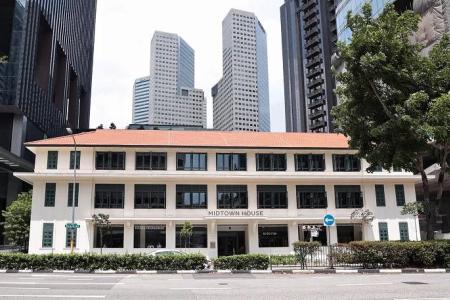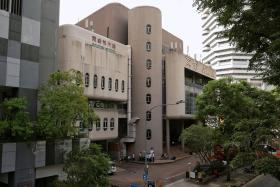Conserved parts of old Beach Road Police Station on display
Nestled among skyscrapers in Beach Road is a Japanese restaurant in a space that, decades ago, was used to house hardcore criminals.
Above patrons eating sashimi and grilled fish in the Setsuri Ishinomaki restaurant, there is a sign of the building’s storied past: small, barred windows that would have let light in for criminals.
Built in the 1930s, the holding cell was part of the old Beach Road Police Station, which once oversaw Bugis and Geylang – where gang fights were commonplace – and was once known as the police force’s “toughest division”. Its officers helped manage unrest and restore order during race riots in the 1960s.
The barred windows were one of the elements that developer GuocoLand and architectural conservation consultancy Studio Lapis brought back as part of efforts to conserve the old police station.
Work on the colonial-era building, which was given conservation status in 2002 and marked as a historic site in 2003, was completed in January 2024. It is now part of the new Guoco Midtown development, a 3.2ha mixed-use site.
Visitors to the area will be able to learn more about the building’s heritage come October, when GuocoLand and Studio Lapis put up educational panels around the development to explain how the police station evolved through the years, and how officers and their families lived within the compound.
The developer’s project and product director Jois Phoo said the former Beach Road Police Station represents a part of Singapore’s early years of nationhood.
“It is a treasured building with memories for many people, from the policemen to the Singaporeans for whom the police helped to provide safety and security,” she said.
Of the entire police station, only the holding cell block and a U-shaped three-storey building that used to house offices and police inspector apartments remain. Other buildings, such as the police living quarters, have been demolished.
Studio Lapis co-founder Ho Weng Hin said one of the challenges in conserving the building was finding ways that would allow people to feel welcome “in a space that was meant to keep people out”.
Large glass windows were added below the original cell windows to allow more natural light into the former holding cells.
The team also peeled back layers of paint to identify the paint colours used back in the 1930s. The windows are now painted in the original dark green, and the walls a shade of cream.
Mr Ho also said the team had to find ways to strengthen the structure of the building because it was tilting.
Built on reclaimed land, the police station’s foundation was found to be sinking even before its completion in the 1930s. But it stabilised and was safe for occupation throughout the years.
Part of conservation efforts included correcting the tilt so people would not notice the slanted walls.
Beams of concrete were built around the slanted pillars in the building to bolster them, said Mr Ho.
GuocoLand also had to deal with the fact that the police station was about four steps lower than the rest of the development, which had to be built higher to meet building requirements to prevent flooding.
As it was surrounded by skyscrapers, this could have led visitors to feel like they were being “towered over”, said Ms Phoo.
The decision was made to build a two-storey glass shelter over the adjacent open-air Midtown Market area, which would give a feeling of spaciousness without making people claustrophobic, added Ms Phoo.
The benches there are topped with wood salvaged from windows of the demolished police living quarters.
Mr Ho told The Straits Times that he hoped people would be able to “feel an interesting dialogue between the old and the new” when they visit.
Mr Eddie Tan, 46, who had lunch with some friends in Setsuri Ishinomaki on July 31, said he had not known the restaurant used to be a holding cell.
The healthcare administrator, who served his national service at the nearby Beach Road army camp, told ST he felt a sense of nostalgia being back in the area.
“It brings back lots of memories. Despite its dark past, it’s nice that this is now a place where people can enjoy themselves,” he said.
Get The New Paper on your phone with the free TNP app. Download from the Apple App Store or Google Play Store now


